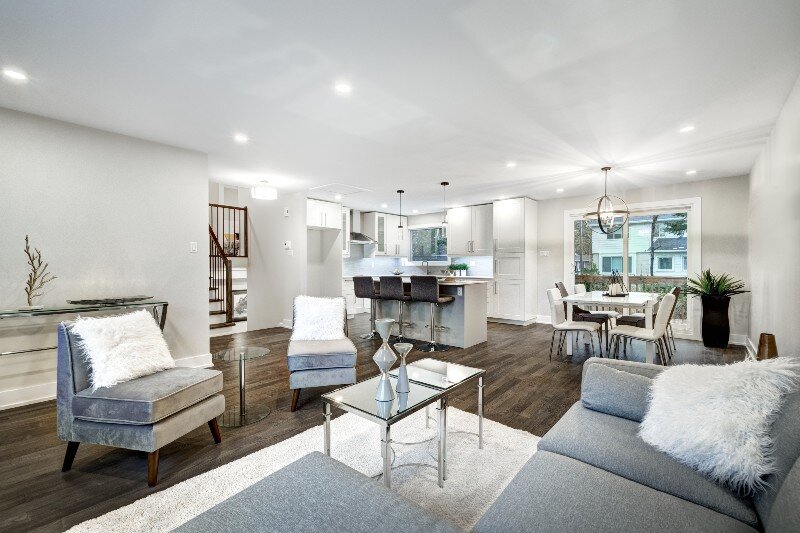
Staging your home can help to give it a polished and inviting look that potential buyers will appreciate, which can help to increase its appeal and value. However, since there’s no one-size-fits-all method to home staging, you might struggle with some trial and error at first.
Whether selling a house with a lien attached in Philadelphia, a home stager, or an experienced real estate agent, you should know the most common rules for staging a house for sale.
Where To Start: Staging Tips for Selling a House
When you start staging a house, it’s best to work from the top down. In other words, aim for the whole-house projects first before moving on to the smaller projects outlined below. So, keep reading for your guide to cleaning a hoarders house before selling.
Clean and Declutter
Potential buyers will likely want to envision their belongings in the house, and that’s tough to do if someone’s belongings are everywhere. A clean and clutter-free home will show much better than a messy one.
Be sure to dust, vacuum, and scrub all surfaces and clear out countertops, shelves, and storage areas. It might help to hire an outside cleaning company if you have a lot on your plate.
Make Repairs and Updates
The last thing you want is a potential owner finding crooked cabinets or a leaky roof. So, make any necessary repairs, upgrades, or renovations before staging it for sale.
For example, fix chipped paint, loose knobs, or leaky faucets. Also, repaint trim in high-traffic areas to freshen it up. Finally, give the house a once-over to identify any more extensive repairs that might need to be addressed.
Depersonalize the Home
Finally, you want potential home buyers to be able to see themselves living in your home, so it’s essential to remove any personal touches where possible.
Personal items include family photos, memorabilia, and anything that shows the house belongs to someone else. Buyers shouldn’t get distracted by any belongings. Instead, you want them focused on the house itself.

Ten Useful Tips on How To Stage a House
Now that you understand the foundational tasks of pre-staging, it’s time to look at the next steps. Here’s how you sell your house with unpermitted work by staging a home properly.
Focus on the Right Rooms
According to the National Association of Realtors (NAR), you’ll want to focus on the living room, kitchen, and master bedroom. You don’t need to spend time or money staging your home office or playroom.
So, make sure the kitchen appliances are gleaming when prospective buyers arrive. Add nice bedding and a few throw pillows in the master bedroom, and include living room furniture that matches the house’s style.
Make It Inviting
When staging a home, you should always create an inviting atmosphere. Consider adding some subtle but pleasant touches that make your house feel warm. The goal is to make buyers feel at ease as soon as they step through the door.
For example, you could use natural lighting and put scented candles in the kitchen to give the room a homey feel. Light fixtures should be bright enough to be welcoming but dim enough that buyers can see what they look like.
Stick to Neutral Colors
One of the most important aspects of staging a house is choosing furniture and décor that’s understated. While bold paint colors and patterns can add visual interest to a room, they may not necessarily appeal to some buyers.
Consider beige tones in the master bedroom to provide a relaxing feel. In the living room, go for a muted color scheme and try white curtains in the master bedroom to open the space up.
Highlight the Best Features
Always aim to highlight a home’s best features during staging. You want buyers to see everything a property has to offer. So, take time to clean, rearrange, and change things as necessary.
For example, if you have hardwood floors in the living room, get them polished and remove any area rugs. If there are walk-in closets in the bedrooms, organize them properly to showcase spaciousness.
Freshen up Your Curb Appeal
Next, you’ll want to pay attention to curb appeal, so your house’s exterior looks just as good as the interior. First impressions are everything, so it needs to look its best from the street.
Essentially, you want buyers to picture themselves lounging on the porch or backyard. So, give your deck a new coat of paint and keep the garden clean and tidy. Plant some in-season flowers out front, and trim the lawn before each showing.
Create a Living Space
When staging a house for sale, it’s important to balance making a space feel lived-in but not overly personal. Buyers want to feel like a home’s living area is waiting for someone to enjoy it, so try to make the experience fun for everyone.
The living room, den, or other living spaces should be arranged conveniently and comfortably. So, if there’s a TV above the fireplace, orient your sofas and coffee table around it. You could also add a few throw pillows to the sofas as a finishing touch.
Highlight Potential
One of the 4 golden rules of home staging is demonstrating your home’s potential. Potential buyers don’t just want to see themselves in your home. Instead, they want to see their children, families, and friends enjoying the house with them.
As a start, set an inviting tone in the kitchen with muffins and cider to showcase it as a family gathering space. Prepare the dining room table with candles and a simple tablescape so buyers can see holiday dinners with family and friends.
Reconsider the Layout
When considering home staging tips and ideas – 4 rules to follow often note the importance of the layout and flow of your space. So, consider removing bulky furniture or rearranging the furniture to make each room appear more open and inviting. Rent a temporary storage unit, if necessary.
A good layout is especially crucial in living and sleeping areas. With that in mind, keep it simple in the master bedroom by only including the basics—a bed, nightstands, dresser, and vanity. Similarly, remove overstuffed furniture in the living and replace them with sleek yet comfortable pieces.
Consider Hiring Professionals
Although you might want to DIY your home staging, sometimes it might be best to reach out to a staging company. Professional stagers can find features to highlight and tell you which areas aren’t priorities.
If, say, you’re focusing on the kitchen, a stager could help you wrap that up and move on to the master. Similarly, they can redirect your focus to the areas that need the most attention, such as the dining or living room.
Look at the Small Spaces
Once you’ve finished staging the main living areas, you can take some time to focus on less-traveled rooms. So, if you have the time, an office space, bonus room, or finished basement are all excellent functional spaces to show off.
So, consider putting a polished furniture set in your office. Invest in a new organization system for your basement, and set up your bonus room in a way that highlights exactly how functional it can be.
Why Stage a House and Invest in Real Estate Staging
One of the most significant downsides to home selling is staging costs. Investing in staging materials such as furniture and decor can be expensive, especially when you factor in fees sellers have to pay when selling a house. However, when done correctly, you’ll see a return on that investment in the form of a quicker sale.
Staging Highlights the Home’s Best Features
Whether you have a large, open floor plan or a cozy, well-appointed living room, staging creates an inviting and harmonious environment that highlights the unique qualities of your home. Skimping on staging will only be a detriment.
Staging Makes a Home More Inviting
You can improve the look and feel of a property, making it seem more inviting and comfortable. When buyers walk into a well-staged home during a showing or open house, they’re more likely to visualize themselves living there and thus be more interested in making an offer to purchase it.
Staging Helps You Stand Out
Staging is an effective marketing tool that helps you stand out from other homes on the market. In today’s competitive real estate landscape, it’s crucial to do everything you can to make your home stand out and get a wide range of buyers through the front door.
Staging Helps You Sell Quicker
A staged home often comes off the market more quickly and sells for more money. Additionally, since staging typically doesn’t take that long, this investment brings you closer to making a quick sale without worrying about the financial burden of maintaining an unsold property.
Staging Creates a Connection
By appealing to their sense of style and highlighting the best features, staging helps buyers envision themselves living in your home.
Showcasing features can be particularly beneficial for buyers who aren’t familiar with the area, and might otherwise be hesitant about committing to a purchase.
Final Thoughts: Rules for House Staging
Even if you’re selling a house with tenants in Philadelphia, you don’t need a degree in interior design to stage a home properly, nor do you need to be a professional stager. Staging a house for sale is an easy and affordable way to elevate your home’s look and appeal, which can help you get top dollar for your property.

 Call Us!
Call Us!